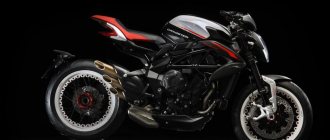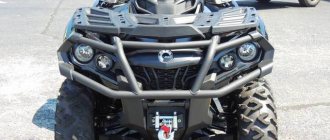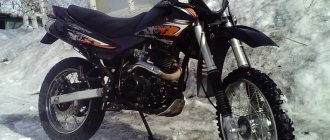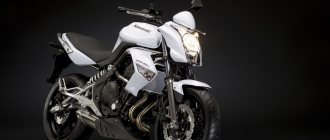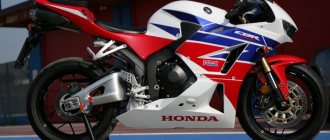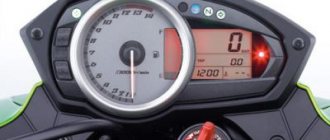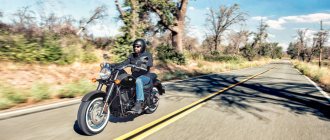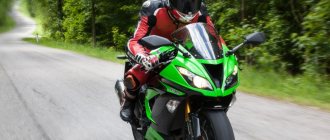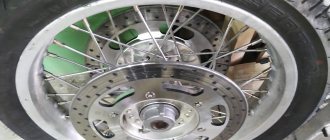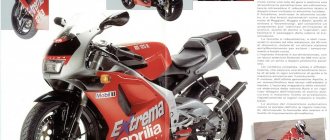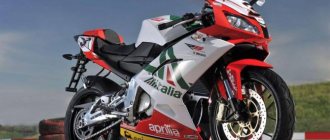The fact that the basic version of a given motorcycle is often poor is primarily determined by the manufacturer’s desire to reduce the price as much as possible. The MV Agusta F4 proves that this is not always the best way.
MV Agusta F4
Finally, the sun's rays chased away the gloomy gray winter and brought us some warm days, so I made it to the brand new MV Agusta F4. The basic version, which is the gateway to the world of F-four. More equipped models are F4 R and F4 RR. In the base F-four you won't find forged aluminum wheels, electronically adjustable Öhlins suspension, or 201 hp. (RR only) under the hood.
The base F-four is powered by a short-stroke Corsa-Corte engine with variable-length intake manifolds. And this means a big increase in power - 195 hp is enough. That power is aided by several electronic gadgets: eight-speed traction control with lean depth sensor, quickshifter, multiple ignition maps (Sport, Normal and Rain modes - the latter cuts power to 150 hp) and ride-by-wire mode. In addition, you can create another map, recording the engine braking force, its reactions, the sensitivity of the throttle, and setting the maximum speed for each gear. The only thing missing is ABS, but the Italians promise it will be available soon.
The F4 sounds simply divine - it's impressive from idle. However, MV Agusta remained faithful not only in terms of sound. The footpegs are high and the heart is low – old school sports ergonomics. Everything is still done the same way, including the mirrors, used mainly for decoration and turning radius, so as not to embarrass a truck with a trailer.
MV Agusta F4
001_MOTO_0410_014
MV Agusta F4: sportbike, 2010, 998 cm³, 186 hp, 192 kg, RUB 1,000,000.
MV Agusta F4: sportbike, 2010, 998 cm³, 186 hp, 192 kg, RUB 1,000,000.
Of course, you can suffer for the sake of art, which is what the pilots of the previous F4 had to do with its extreme landing and sharp reactions to the throttle. So, going to southern Spain for the Almeria track, I was mentally prepared, so to speak, for the fight, taking into account the weather forecast - about +5 ° C with rain. Not the best weather for a track day, is it? And the glory of the restive horse again... But the Americans from Harley-Davidson, who are now getting rid of “non-core” assets, managed to influence the developers of the new style icon and forced them to improve the manners of the F4.
002_MOTO_0410_014
MV Agusta did not repeat the mistake made by the designers of the Ducati 999 - the external appearance of the updated model has remained virtually unchanged.
MV Agusta did not repeat the mistake made by the designers of the Ducati 999 - the external appearance of the updated model has remained virtually unchanged.
Yes, it is very similar in appearance to the previous one, but it is a completely new motorcycle - down to every bolt. I won't talk about the design and lines - everything is visible in the photo. Stunningly beautiful, don't you agree? Why, this is the most beautiful sportbike in the world! And it was “drawn” by the English designer Adrian Morton, also known for the Benelli Tornado.
A beautiful motorcycle cannot run poorly - and the “re-educated” F4 proves this in the very first laps on the track. Reactions to gas are exactly what they should be, not sharp, but not blurry, Agusta simply “follows the gas.” And this is not superfluous at all, given the complexity of the track and the low temperature. The traction control also helped me a lot to stay within limits, gently correcting me when I overestimated the grip coefficient of the newest Diablo Rossa Corsa tires on the cold asphalt (although the tires were warmed up before the race). A slipper clutch is also in place - where would we be without it now?
Motorcycle MV Agusta F 4 1000R 2007 review
The description of the MV Agusta F 4 1000R 2007 motorcycle is in the queue for publication of the article. Announcement: Today, for almost every new motorcycle that comes into being, marketers strive to carve out their own niche. This one is a road sport, this one is a recreational enduro. But what class should we include a motorcycle that has a little bit of everything? A good bike should have a reliable engine, comfortable ergonomics and simple controls...
MV Agusta F 4 1000R is a motorcycle not sold in Russia, equipped with a very powerful 174 hp engine. Despite the fact that good models of motorcycles have a very respectable price, and the season for their use is relatively short, the motorcycle market is developing rapidly. And if you believe the words of dealers, then some models of recently released motorcycles are selling like hot cakes at the beginning of the season, and the models brought to Russia are clearly not enough to fully satisfy consumer demand.
A motorcycle has long ceased to be an alternative to a car, and the times when this equipment was bought only because there was not enough money for a full-fledged car are forgotten. Nowadays, two-wheelers can be called technological marvels in many cases, and their cost can be compared with that of prestigious cars.
Many people have started buying motorcycles for hobby purposes as riding or even collecting them has become a good pastime for many people. Many motorcycles, for example the MV Agusta F 4 1000R, whose technical characteristics make it possible to call the model a prestigious brand, are in demand among both beginners and experienced motorcyclists.
Motorcycles with an engine capacity of 998 cc. see, appeared as a result of long work of inventors who sought to create a model that was not inferior in characteristics to other versions of the motorcycle. In some cases, these models are not only not inferior, but also ahead of other motorcycles, as they have minimal fuel consumption and other excellent parameters.
Motorcycles with an engine capacity of more than 400 kb. cm, which includes the MV Agusta F 4 1000R - this category of motorcycles simply cannot claim the title of “motorcycle for a beginner.” On the contrary, this is already a serious technique that requires certain control of motorcycle equipment with a smaller engine capacity. Yes, she attracts more attention, she is the most beautiful, fast, interesting and there is a huge selection of models. But as power increases, the weight of the motorcycle inevitably increases. In this class you are unlikely to find motorcycles lighter than 180 kg, unless they are the latest motorcycle models.
Go to the entire range of MV Agusta motorcycles, on this page you can find MV Agusta F 4 1000R motorcycles from other years of production and information about them
004_MOTO_0410_016
They say that perfection cannot be improved... They lie!
The new F4 has become a practical superbike. They say that perfection cannot be improved... They lie! The new F4 has become a practical superbike.
Handling has become simply precise - turning into a turn is now easy and does not require any effort - before this was not all smooth sailing. And you drive on an arc as if in a straight line - miracles, and that’s all. And somewhere around the third lap I felt that I had become close to the bike, that we had become a single organism, that I could only hear the fantastically pleasant sound of the engine, and I had a stupid smile on my face. What a blessing that there are still three sessions ahead... And for the life of me, the “Japanese” cannot give such sensations - they are somehow inanimate, or something. And here you can feel the hand of a master in every detail, it seems that everything here is handmade. Similar to the feeling of an expensive pair of shoes.
005_MOTO_0410_016
MV Agusta is truly a work of engineering and technological art - the first is confirmed by the characteristics, and the second is evidenced by all the details of the motorcycle - each of them is beautifully processed, it’s simply pleasant to hold in your hands.
MV Agusta is truly a work of engineering and technological art - the first is confirmed by the characteristics, and the second is evidenced by all the details of the motorcycle - each of them is beautifully processed, it’s simply pleasant to hold in your hands.
But this is all lyrics, let's get back to the hardware. The F4 has returned to the “true liter” camp, the engine is basically the same as the new Brutale (“Moto”, No. 11–2009), the differences are mostly in the “head”. Titanium valves, eight injection nozzles, variable length of intake pipes - that’s how we gained 186 hp. and the result was a “convenient” torque characteristic. The latter is also due to the weighting of the crankshaft by 2 kg - the predecessor was too harsh in response. In general, the motorcycle lost 10 kg - only on the headlight, and now it has xenon, we saved one and a half kilos, the plastic somehow became lighter by 1.9 kg, the tank, pendulum and wheels were also “fat-free”. And although 192 kg of dry weight is far from a record for sportbikes, you don’t feel it at all while driving, which means everything was done correctly.
Comparison with analogues
The class in which MV Agusta is represented is quite numerous, and it is not difficult to find liter sportbikes as a competitor. But we decided that it would be interesting to compare it with an Italian representative from another company - this is the Ducati 1098.
Ducati 1098 motorcycle
Starting the comparison with the appearance, you understand the relationship between these motorcycles, they are really similar.
Fine. Let's dig deeper. And here we are greeted by the main difference between motorcycles - the engine. Ducati has an L-shaped, two-cylinder, producing 160 hp at 9700 rpm, while Agusta has an in-line four-cylinder with 201 hp. One of the most important indicators for a sportbike is weight, and here Agusta loses by a significant margin with 193 kg versus 171 kg for the Ducati.
Otherwise, motorcycles still have many identical components, and comparing small differences can take a very long time. But the similarity of these motorcycles is that they both rarely appear on the training track. All this is due to the difficulty of repair and the cost of Italian horses.
009_MOTO_0410_017
The variable length of the intake pipes provides increased torque in the mid-speed zone.
The variable length of the intake pipes provides increased torque in the mid-speed zone.
Traction control can be adjusted to eight preset positions, and the principle of its operation is radically different from that used by competitors. The “brain” monitors the change in crankshaft speed and, if the rotation acceleration is too sharp (which indicates wheel slip), slightly strangles the engine. It seems simple, but it works. But how many test kilometers are behind this simplicity? I was amazed (in a good way) by another “simple” technical solution. To change the front wheel, you do not need to pull the axle through the stays - just open the terminals that clamp it. As a result, it takes a little more than a minute to replace the wheel assembly at a pit stop (with unscrewing the calipers... What else is there - the racing history of the brand simply cries out: return Agusta to the track! And something tells me I don’t have long to wait.
006_MOTO_0410_016
Monoblock radial-mounted Brembos have become the standard in the top-end sportliter class for a reason - these are truly the best brakes.
Only the general design with a radial valve arrangement has been preserved from the old engine. But basically the engine is almost the same as the new Brutale - the cylinder heads are different. Increasing the swingarm length by 20 mm has dramatically improved the handling of the previously stubborn sportbike. Monoblock radial-mounted Brembos have become the standard in the top-end sportliter class for a reason - these are truly the best brakes. Only the general design with a radial valve arrangement has been preserved from the old engine. But basically the engine is almost the same as the new Brutale - the cylinder heads are different. Increasing the swingarm length by 20 mm has dramatically improved the handling of the previously stubborn sportbike.
I also had a chance to drive along the mountain roads near Almeria. Since they are similar to the track in all respects (I doubt only about the speed limit - although we did not deny ourselves anything), there is practically nothing to add to the driving sensations. Just a few words about the suspension. It is very comfortable by sportbike standards - uneven asphalt is handled very well, and you don’t lose the intended trajectory even in turns. I won’t be original, but I will say that traction control on a regular road is even more useful than on a track - sand in corners is always inappropriate...
MV Agusta
Looking at the new 2010 MV Agusta F4 sportbike, it's hard to say that it has been completely redesigned.
The "new" bike is similar to the "old" F4, which was very good, but a decade old design. But MV Agusta is unshakable, they stand their ground and claim that they have completely redesigned the motorcycle, creating a new body, engine and chassis. The weight of the new F4 has been reduced by 10 kg, the engine has become more compact and smaller in volume, from 1,078 cm3 to 998 cm3. Although 186 hp. should be quite enough.
Among the new elements, parts and assemblies one can note: - new air intakes of variable length; — two fuel injectors for each cylinder — Marelli 7BM ECU (interconnected with an eight-level traction control system); — 20 mm longer and lighter single-sided pendulum; — redesigned wheels; — new body design; — redesigned exhaust system pipes; - a lot of machine changes that can be replaced by three words: lighter, more powerful and more reliable.
Suspension includes 50mm Marzocchi forks with three levels of adjustment at the front and a Sachs monoshock at the rear. The braking system, as expected for a good motorcycle, is Brembo: 320 mm discs with four-piston monoblock calipers at the front and a 210 mm disc with four-piston Nissin calipers.
The unladen weight of the MV Agusta F4 2010 is only 190 kg, which together with 186 hp. gives a top speed of 303 km/h.
Technical characteristics of MV AGUSTA F4 2010:
Type: four-cylinder, four-stroke, 16 valves Timing: DOHC Displacement: 998 cc Starter: electric Bore x stroke: 76 mm x 55 mm Power: 137 kW (186 hp) at 13500 rpm Torque: 114 Nm at 9600 rpm Cooling: separate liquid and oil coolers Fuel system: Magneti Marelli IAW 7BM injector Clutch: oil bath multi-plate clutch Gearbox: 6 speed Prime mover: 50/79 Gear ratio: First gear: 13/38 128.2 km/ h Second gear: 16/34,176.4 km/h Third gear: 18/32,210.8 km/h Fourth gear: 20/30,249.8 km/h Fifth gear: 22/29,284.3 km/h Sixth gear: 19/23 305.0 Voltage: 12 V Alternator: 350 W at 5000 rpm Battery: 12 V - 8.6 Ah Wheelbase: 1430 mm Length: 2100 mm Overall width: 750 mm Seat height: 860 mm Ground clearance: 115 mm Trail: 100.4 mm Weight: 192 kg Fuel tank capacity 17 l Top speed: 303.0 km/h Frame: steel tubular frame, welded, CrMo, aluminum alloy swingarm Front suspension: telescopic fork, adjustable Diameter: 50 mm Travel: 120 mm Rear suspension: 1 shock absorber, adjustable, swingarm Travel: 120 mm brake system Front brake: two 320 mm discs, caliper 4 pistons Ø 34 mm Rear brake: steel disc 210 mm, caliper with 4 pistons Ø 25.4 mm Wheel front: aluminum alloy 3.50 "x 17" Wheel rear: aluminum alloy 6.00 "x 17" Tire front: 120/70 - ZR 17 M/C (58 W) Tire rear: 190 /55 — ZR 17 M/C (75 W) Fairing: thermoplastic
Photoshoot
008_MOTO_0410_016
The Sachs backpack shock absorber is also fully adjustable.
The Sachs backpack shock absorber is also fully adjustable.
Civilian riding revealed one drawback (although this is different for everyone) - the motorcycle is a bit high on the saddle. But in general, the landing was changed in the direction of humanism, it is very comfortable to fly and you don’t feel like a shrimp (although you can comfortably lie down on the tank). Hanging over is also comfortable for me, although tall colleagues complained that the footrests could have been lower.
003_MOTO_0410_016
Now you can sit on the F4 without feeling like a shrimp - the landing has become much more comfortable.
Now you can sit on the F4 without feeling like a shrimp - the landing has become much more comfortable.
In addition to many other things (including for racing), the list of original tuning includes adjustable footrests. Another “blot” - in the beautiful mirrors with built-in LED turn signals, only your own forearms are clearly visible, so if for some reason (but why - everyone has long fallen behind!) you need to look behind you, you will have to look back. True, the mirrors on sportbikes differ only in the degree of uselessness... And completely without looking back or making reservations, it is now clear that the top “liters” have a competitor in the F4. Which in all respects competes with the S1000RR and 1198S, not to mention the canonical “fires”, “erks” and “jixers”. And I tell the “racers” and riders a secret - you have to take it!
Test drive MV AgustaF4 1000 Tamburini
The name “MV Agusta” is rarely remembered among Ukrainian motorcyclists, but not because the brand is not worthy of it, but because of its exclusivity, high cost and, accordingly, extremely low popularity. Popularity, but not fame!
MV Agusta sportsbikes are “widely known in narrow circles” and true connoisseurs of such equipment are well aware of all models/modifications of the brand. Quite a large number of world-famous stars own motorcycles of this legendary brand. By a lucky chance, we came across an “exclusive within an exclusive” - a copy of the MV Agusta 1000 F4 limited edition Tamburini, produced in 2006, and we, of course, could not let it pass and not test it. For those who are not very “in the know”, there is information: fewer of these motorcycles were produced than the Ferrari F50 - only 300 copies. Despite the exorbitant price (in the USA their cost was $42,650), they were all sold out...
Now there is a crisis and some very expensive exclusive motorcycles are being sold incredibly cheaply, such is our life! Moreover, we were interested in tasting this “candy.”
Massimo Tamburini, in fact, is the author of the design of all the latest “masterpieces” from MV Agusta. The bikes that came out into the world from the hands of this maestro of motorcycle design have always been distinguished by outstanding external characteristics. Our counterpart is no exception. When the simple liter Ef-four was first shown at the Milan exhibition, it created a sensation. Photos of four pipes elegantly peeking out from under the “tail” were circulated in all specialized publications. Although this is not the only beautiful element in the motorcycle, it is not its individual parts that attract attention. He is all in harmony! The limited version of Tamburini differs from other F4s in its color scheme “red top - black bottom”, some decorative elements, wheels and seats made of perforated red leather of a special Italian finish.
Approaching the motorcycle, I felt my heart beat faster at the sight of the battery of four mufflers familiar from the photo, the elegant frame and silhouette. All the pictures are certainly impressive, but in reality this bike looks extremely fast! There is no doubt that this is exactly how it should feel and drive. At the first glance at the dashboard, the tachometer without a red zone, marked up to 17,000 rpm, inspires respect.
I can't wait to test it on the go and see how harmonious it will be in motion. The sound of the engine idling has already promised a lot of interesting things - it is low and deep, I would even say that it sounds noble. Moreover, what’s interesting: it would seem that it looks like the same in-line four as on the popular Japanese ones, but it works completely differently!
The ergonomics of the model are worked out so well that even when you sit in the saddle of this motorcycle for the first time, you don’t feel the slightest discomfort. After all, Italians know how to build motorcycles! Everything is predictable, everything is in place. The gas tank is somehow “Italian-style” narrow where the legs touch it, which makes it easy to hang down and feel the motorcycle more acutely in corners. The clutch lever caused slight bewilderment. I don’t remember a motorcycle on which I had to squeeze it with not two, but four fingers. And not because it was tight, but because of the moment of operation (at the very end of the lever stroke) when the handle was fully squeezed. If you squeeze it with two fingers, the lever rests on the fingers remaining on the steering wheel, the clutch does not disengage completely, which causes difficulties in finding “neutral” and rough gear shifting. Although, I am sure that this inconvenience can be easily corrected by adjustments and pumping of the hydraulic drive line.
When leaving the parking lot, I noticed the smooth, simply “tractor” traction at idle speed - there was not the slightest hint of twitching! A moment that is clearly not typical for most sportbikes, gives this F4 a clear advantage over its competitors in city traffic jams - you don’t have to nervously push the gas with the clutch half-depressed, crawling towards a traffic light between dense rows of cars.
The throttle grip is very short, the sector from zero to maximum is less than 900, so even with delicate handling, the motorcycle is very sharp, which is not bad for the track, but slightly annoying in city traffic.
Having escaped to a free area, I accelerated slightly, while deliberately driving along the intermittent markings and now I can definitely say that this experiment should not be repeated on a wet surface! Even on dry, warm pavement, I felt the rear wheel spin slightly, losing contact as it hit each white stripe. But, characteristically, I did not experience any extreme sensations - the excellently tuned chassis makes the behavior of the motorcycle stable and predictable, and this is felt throughout the entire speed range, from minimum to 185 miles per hour - I was not able to accelerate further due to the rather dense traffic on Boryspil Highway.
Here it’s worth inserting a few words about acceleration on this “rocket”. In first (and quite “long”) gear, the bike accelerates to 135 km/h and, if you don’t restrain its impulse, it instantly goes into a wheelie. But that's not the point. Remember that its tachometer does not have a red zone, but is marked up to an impressive 17,000 rpm? So: the pasta makers are fooling our brother, oh, how they are fooling us! Exactly at 13,000 rpm the computer makes a cutoff... and that’s it, here we go, finita la comedia! Well, yes, well, yes... There’s no need to roll your lip - after all, I knew that the timing drive here is normal, and not desmodromic, like on Ducati! And even there the cut-off switch works, what could one really hope for a miracle when the valves are closed by ordinary springs...
But there were much more pleasant moments. As I rolled onto the motorcycle, I never ceased to be amazed at how the manufacturer managed to combine stability in the motorcycle’s behavior on straight lines with incredible ease when changing the trajectory. It seemed that the bike turned not by countersteering or tilting the body, but by obeying the movement of the eyebrows, no more, no less. He raised the left one - he went to the left, the right one - to the right. Yes exactly! And this despite the fact that this MV Agusta model weighs significantly more than any of the competing sportbikes.
What is the secret of such controllability? Sachs shock absorber, ultra-light Marchesini wheels, cantilever, but very light and stiff pendulum, plus an expensive Marzocchi fork - torsionally rigid and easy to ride. Just look at its feathers alone, with an internal tube diameter of 50 mm, coated with titanium nitride for better gliding! And the motor does its bit. Yes, yes, no matter how strange it may seem, but the exquisite traction control allows you to dose it very clearly in high-speed turns, choosing the optimal trajectory for their passage. But it is worth clearly understanding that in certain transitional modes of civil (especially urban) use, the F4 Tamburini will seem a little nervous.
In general, from such an aggressive-looking motorcycle I expected tooth-crushing stiffness of the suspension, but on the move it turned out that its perfect settings (for different speeds) provide a very high-quality progressive compression-rebound characteristic. In simpler terms, it doesn’t shake on small bumps, and doesn’t break through on serious bumps. The suspension feels composed, but at the same time very comfortable and even luxurious, or something (as far as this term is generally applicable to superbikes). If we allow a car comparison that is not entirely correct for a motorcycle magazine, then I would say that this MV Agusta drives like an expensive “charged” sports Mercedes, despite the fact that Japanese “liters” are at best comparable to a Toyota Camry. It turns out that if good engineers are given the right task, they can easily combine incompatible things!
As for the brakes, I expected more sharpness from such serious components, but the braking on the MV Agusta F4 1000 was surprisingly very confident. The information content of the deceleration control is beyond praise. The force on the handle is measured very clearly and the moment the wheels lock does not suddenly catch the pilot.
The motorcycle does not leave indifferent either the one who controls it or the other participants in the movement. The passing Maserati nodded in understanding and gave a thumbs up. And then some guy in a well-worn Daewoo Nexia standing nearby at a traffic light studied the motorcycle for a long time, and then said: “What, is there a disc brake on the back?” I could only shrug my shoulders - we still have the majority of such “connoisseurs” of motorcycles of exclusive brands...
Emotions of the owner of MV Agusta F4 R312, Anatoly Evdokimov:
I'm in 2nd, 3000 rpm, speed 60 km. Smoothly I begin to “unscrew”. That minute everything made sense - the awkward landing at first, this reaction to the gas... Everything became as good as possible, exactly what was needed! As soon as this thought entered my head, the sound of the “motor” immediately changed to a dissatisfied, like a glance from under the brows, strangled ringing, which soon turns into an indescribable scream and whistle, like on a fighter jet. A look at the instruments - 130/8500 rpm. Even louder, it carries me back, pulling my wrists and head. “I’m pressing with my chest,” it’s as if the motorcycle’s roof is being ripped off – it’s rearing up. I lean forward in horror. As soon as the wheel touched down, I experienced an acceleration of such force that my vision became a little blurred. A glance at the speedometer - 160/12000, still in second. I give it 3rd, he presses even harder. Everything happens in a matter of seconds. The truck that I saw in the distance moments ago is now moving towards me at terrible speed, I immediately make a left and pass it at 190. I let off the gas, not understanding what the hell just happened. Everything was too fast - I stupidly didn’t catch up. 130 km/h, I put my brains together and open the gas again. A jerk, again that whistle and an angry scream, similar to the one made by a Ferrari. It can’t be like this, can it really happen so quickly??!!! Clutch again, up one more. Everything is instinctive and easy. Having never ridden a sports car before, the body itself understood what to do, the leg itself clicks through the gears... My vision is cloudy, my neck is stretched, I glance down - there are only quickly changing numbers - 150-170-192-210-224-240 -270….. I'm shocked. I have never driven so fast in my life... I catch myself thinking that I am smiling like a “down” and my eyes are a little watery. I have wild delight and surprise, bordering on disbelief. I drop to 140, 6th and I’m just driving. How to describe? Smooth, calm, and confident. My muscles relaxed and I felt like God. Just for fun, I revved the gas a couple of times - the car immediately jerked stupidly away from the cars walking nearby. And what about the drivers' gaze? "Erks" and "Jixers" - you know what I mean. For them, we are in another dimension, where Newton is only an adviser, but not a ruler. I haven’t felt such a sense of greatness and self-worth since my first parachute jump.
Oh yes, braking. This motorcycle reads your wishes... It does everything exactly the way you want. He is as efficient as a bullet. Clearly, accurately and without unnecessary movements. Of course, a lot depends on the “shooter”. The main thing is to know what you want, otherwise it will “reject”. This motorcycle loves confident, clear rider actions. In return, he will multiply you by 2. Everything about him guarantees a buzz. And the look, and the sound, and the suspension, and the engine. The main thing in “liters,” as I understand it, is still confidence. You can and should push the bar - but you need to do it wisely. Yes, he pushes to “sin”. But once you understand him, he understands you. NOT the other way around.
History of MV Agusta
The founder of the MV Agusta company was Domenico Agusta, the son of Count Giovanni Agusta, who, after the death of his father and even before the end of World War II, since 1943, without stopping the main (aviation) direction, began to develop the production of motorcycles. In part, this step can be explained by the exorbitant craving of young Domenico for motorcycles, motorsports and everything connected with them. The engineers' first task was to develop a lightweight motorcycle.
They called this device “Vespa 98”, which means “wasp” in Italian. Domenico simply did not know that a company had already been created that began production of the future scooter masterpiece with the same name. The name of the first-born with a two-stroke 98 cc engine and a two-speed gearbox remained the same, and since 1946 he called it Domenico.
Already in 1948, the company's first racing motorcycle appeared. Outwardly, it was very similar to the production model, but the engine capacity was increased to 125 cubic meters, and the power was increased to 8 hp, which allowed it to reach a “maximum speed” of 110 km/h. A year later, the engine of the modernized version developed 10 hp. and was coupled with a 4-speed gearbox.
Domenico understood that the possibilities of his company were not limitless and that racing vehicles needed to be built separately from production ones, and that the best specialist should do this. Then he lured two people from the Gilera company at once: designer Piero Remor and mechanic Arturo Magni, who had weight in the motorcycle world and had just developed a four-stroke engine. And the work began to boil! Since 1950, a whole family of four-stroke racing motorcycles has been launched, with engines ranging from 125 (one cylinder) to up to 500 “cubes” (four). But no matter how perfect the motorcycles were, it was impossible to achieve significant results without the best riders. As a result, in 1950 the “125” won the Dutch TT competition. The following year, Englishman Lens Graem won the international race on a 500 cc motorcycle, and a year later another Briton, Cecil Sandford, won the world champion title in the 125 cc class. In the same year, a telescopic fork appeared on MV Agusta motorcycles, and in 1955 the Italian racer Carlo Ubbiali was already on the podium. In 1956, the MV Agusta team won victories in several classes at once (125, 250, 500 cm3), declaring itself very seriously. Thanks to numerous sporting successes, the company has secured a market for its products in the light motorcycle sector (125-175 cm3) and for the next 15 years they will form the main range in the MV Agusta product line. Until the early sixties, the company's racing motorcycles reigned supreme in circuit racing - in 1957, by agreement, all Italian motorcycle manufacturers left the tracks.
But from the beginning of the 60s, the European markets began to be powerfully attacked by the Japanese (especially Honda), displacing all European brands (including MV Agusta) from the “ring” pedestals in the classes of 125, 250 and 350 cm3. Only the royal 500cc class, dominated by the three-cylinder MV Agusta, piloted by the famous Englishman Michael Hailwood, did not submit to them. But the Japanese resorted to a trick and bought Hailwood. Then Domenico bet on another rising star of motorcycle racing - Giacomo Agostini, retained the old ones - Carlo Ubbiali, and also attracted new talented pilots to the team: John Surtees and Phil Read. . The result was impressive: for almost ten years, until the early 70s, MV Agusta dominated the royal class of MotoGP! In 1965, at the Milan Motor Show, the company presented the then sensational MV Agusta 600 road motorcycle with a four-cylinder engine (DOHC, 52 hp, 5-speed gearbox and disc brakes, 185 km/h), and in ’69 modernizes it (750 cm3, 69 hp and a mind-blowing 215 km/h). The company is gaining a reputation for producing expensive, but the fastest and most technologically advanced road motorcycles. Honda was hot on the count’s heels with its CB750, which, although slower, was much cheaper.
Perhaps MV Agusta took some more serious steps in the market, but in 1971 Domenico Agusta, who believed that the best motorcycles in the world cannot be a mass product, dies, and with him the main driving force leaves the company. For some time, the company, so to speak, by inertia, was the leader in motorcycle racing (Phil Reed brought the last victory to the brand in 1974). For some time the company stayed afloat thanks to the efforts of engineer Arturo Magni, who believed in Count Agust’s ideas (whom the Count lured away from Gilera less than 30 years ago), and even produced new, more powerful and faster models, but over time it still “sank to the bottom.” A new era for the MV Agusta brand began in 1991, when the Castiglioni brothers (owners of Cagiva) acquired the rights to the brand with the aim of reviving its former glory. But, unable to finance the development of a new supermodel, they sold a controlling stake to competitors from Ducati. And in 1997, the F4 (750 cm3) was shown in Milan, whose exquisite design and ultra-modern “filling”, as well as a price of almost fourty thousand greenbacks, made everyone talk about the revival of the glorious brand. Since then, the brand has been sold and bought twice more: in 2009, Harley-Davidson became its owner, but the crisis crippled even such a legendary company and in August of this year the Castiglioni brothers bought their “pearl” back. Rumor has it that Silvio Berlusconi had a hand in this, and therefore we should wait for the release of a limited edition with the abbreviation SB (Silvio Berlusconi)...
Text: Alexey Eroshchenko
Photo: Andrey Shlenchak
Equipment: ParkDrive motorcycle showroom
(Kyiv, Protasov Yar st.)
